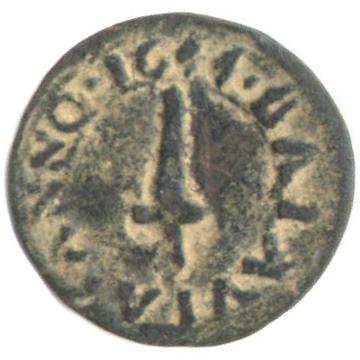| SPECIFICATIONS | |
| Denomination | Half Stuiver |
| Alloy | Copper |
| Type | Struck | Diameter | 30. mm |
| Thickness | mm |
| Weight Legal | 6.866 gms |
| Weight | 6.04 gms |
| Shape | round |
| Edge | Cast |
| DieAxis | O° |
| Mint | Nagapatam |


|

|

| ||||||||||||||||||||||||
| Like Indonesia KM#31 | ||||||||||||||||||||||||||
Obverse : The arms of Batavia (vertical sword) in inner circle
along periphery the legend BATAVIA · ANNO · 1644
· with date on top and within outer circle
Reverse : VOC monogram below the value · ½
· ST · all within a line circle.
VOC monogram
of the Dutch East India Company has a large V superimposed on
OC.
Codrington (page 111 13.) noted that many of the tammekassen found in Lanka are considerably lighter than the prescribed weight of 7.72 grams for coin made at Batavia in 1644.
The half Stuivers were known as "tammekasje" (Tambakasi in Sinhala) in Lanka. Codrington (page 139 36.) associates this coin with the tammekasje made in Negapatam in 1675. According to Thunberg, this coin in 1775 had then more currency in Coromandel than in Batavia ( Vol. III 354) ; they are fairly common in Ceylon.
Jan Lingen disagrees with this view and supports Scholten's statement (page 152) that associates the 1675 Negapatam mintage with the Divided wreath type one Stiver coin. I am yet to find divided wreath type Stiver in Lanka. In contrast IMHO the 1/2 Stiver is far too common in Lanka to be all from the Emergency issue minted in Batavia during a month in 1644.
In 1673 Vijayaraghava, the last of the old Nayak dynasty of Tanjore, ceded Nagapatam to the Dutch and till 1680 was under the Government of Ceilon. In 1675 the council of Nagapatam resolved that the Artisans who had been driven from there homes by wars be employed, among other things, in making copper tammekassen, such as were then current in the Island and that 400 chests of bar copper be sent thither to be coined.
According to the memorandum drawn up by Governor R. Van Goens, Jr. for his successor, Laurens Pyl, the inferior had driven out the better money to such an extent that in 1679 the currency consisted almost exclusively of copper money.
The legal weight of the Nagapatam 5 Cash (from Scholten) make this speciman 12.2% under weight. Another lower grade coin I found in Lanka was 4.3% under weight. Both are probably 1675 reproductions from Nagapatam.
The Dutch first appeared off the coast of Lanka in 1602. They entered into a treaty of commerce with the King Vimala Dharma Surya [1597-1604] of Kandy with the object of ousting the Portuguese and they obtained protection and free trade for cinnamon and pepper.
In 1638 King Rajsinha II[1635-1687] of Kandy called upon the Dutch to help him against the Portuguese and they now took one place after another, including Galle in 1640 and Colombo in 1656. By the time Jaffna had fallen into their hands, in 1658, they had taken possession of all the ports of Lanka.
Edited from
The Coins of the Dutch Overseas Territories- 1601-1948
C. Scholten, 1953, Amsterdam: Jacques Schulman.
The coin was scanned at 300 dpi and displayed at 250 dpi. It was obtained in December 1999 from Rajah Wickremesinhe an Author and collector in Colombo, Lanka.